Lemon Myrtle, Lemon Ironwood, Lemon Scented Myrtle
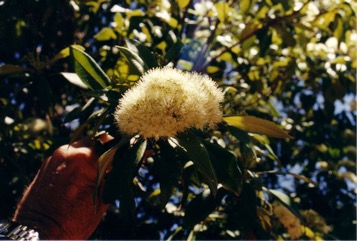
A tropical and subtropical plant. Plants grow naturally in Queensland in Australia. They required acid well drained soils. A pH of 4.5-6.5 is suitable. A rainfall in the range 800-1100 m is adequate. It occurs naturally in the rainforest. It suits humid locations. Sheltered warm situations are needed and regular watering during dry periods is important. It is damaged by frost. It needs a minimum temperature above 5-7°C. It suits hardiness zones 9-10. Coffs Harbour Botanical Gardens.
Also known as:
Pohon surawung
Edible Portion
- Leaves - flavouring, Spice
Where does Lemon Myrtle grow?
Found in: Africa, Asia, Australia, China, Indochina, Indonesia, North America, SE Asia, South Africa, Southern Africa, Thailand, United States
Notes: There are 7-13 Backhousia species. They occur in Australia.
Growing Lemon Myrtle, Lemon Ironwood, Lemon Scented Myrtle
Cultivation: Plants can be grown from cuttings. It is important to use clonal propagation as oil quality varies considerably. Semi-ripe cuttings should be used. Plants can however be grown from seed. Seed should be near the surface and need temperatures above 13-15°C. Plants should be 3 m apart and well composted and mulched sites give better production.
Edible Uses: The leaves are used for flavouring and in herbal teas. They can also be dried and crushed and used as a spice. They are used in cakes, biscuits, sauces and desserts. They are also the source of an essential oil.
Production: It is fairly slow growing. Leaves can be picked throughout the year. The older, mature, dark green leaves have the best flavour.
Nutrition Info
per 100g edible portion| Edible Part | Energy (kcal) | Protein (g) | Iron (mg) | Vitamin A (ug) | Vitamin c (mg) | Zinc (mg) | % Water |
|---|---|---|---|---|---|---|---|
| Leaves - flavour | - | - | - | - | - | - |
Lemon Myrtle, Lemon Ironwood, Lemon Scented Myrtle Photos

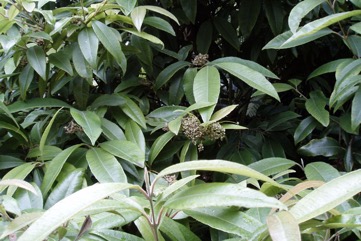
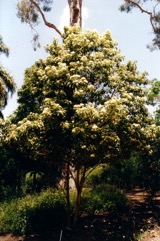
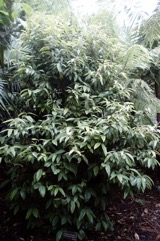
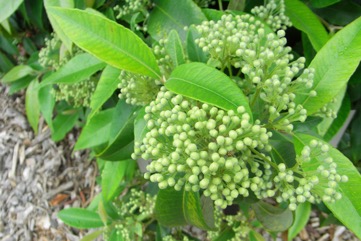
References
Alice, L. & O'Quinn, T., Australian Bush Superfoods. Explore Australia p 90
Anon., 2003, Native Plants for the Fitzroy basin. Society for Growing Australian Plants Inc. (Rockhampton Branch)
Barwick, M., 2004, Tropical and Subtropical Trees. A Worldwide Encyclopedic Guide. Thames and Hudson p 41
Bodkin, F., 1991, Encyclopedia Botanica. Cornstalk publishing, p 124
Bonney, N., 1997, Economic Native Trees and Shrubs for South Australia. Greening Australia (SA) inc. Campbelltown SA 5074 p 34
Brickell, C. (Ed.), 1999, The Royal Horticultural Society A-Z Encyclopedia of Garden Plants. Convent Garden Books. p 158
Brown, D., 2002, The Royal Horticultural Society encyclopedia of Herbs and their uses. DK Books. p 139
Cooper, W. and Cooper, W., 2004, Fruits of the Australian Tropical Rainforest. Nokomis Editions, Victoria, Australia. p 342
Cronin, L., 1989, The Concise Australian Flora. Reed. p 166
Cundall, P., (ed.), 2004, Gardening Australia: flora: the gardener's bible. ABC Books. p 215
Elliot, W.R., & Jones, D.L., 1982, Encyclopedia of Australian Plants suitable for cultivation. Vol 2. Lothian. p 267
Etherington, K., & Imwold, D., (Eds), 2001, Botanica's Trees & Shrubs. The illustrated A-Z of over 8500 trees and shrubs. Random House, Australia. p 112
Facciola, S., 1998, Cornucopia 2: a Source Book of Edible Plants. Kampong Publications, p 140
Fragm. 1:78. 1859
Greig, D., 1996, Flowering Natives for Home Gardens. Angus & Robertson. p 59
Hemphill, I, 2002, Spice Notes. Macmillan. p 224
Jones D, L, 1986, Ornamental Rainforest Plants in Australia, Reed Books, p 67
Lord, E.E., & Willis, J.H., 1999, Shrubs and Trees for Australian gardens. Lothian. p 12
Melzer, R. & Plumb, J., 2011, Plants of Capricornia. Belgamba, Rockhampton. p 220
Molyneux, B & Forrester, S., 1997, The Austraflora A-Z of Australian Plants. Reed. p 47
Nicholson, N & H., 1996, Australian Rainforest Plants 2, Terania Rainforest Publishing. NSW. p 12
PROSEA handbook Volume 13 Spices. p 274
Ratcliffe D & P., 1987, Australian Native Plants for Indoors. Little Hills press. p 60
Robins, J., 1996, Wild Lime. Cooking from the Bush food garden. Allen & Unwin p 136
Seidemann J., 2005, World Spice Plants. Economic Usage, Botany, Taxonomy. Springer. p 61
Smith, K & I., 199, Grow your own bushfoods. New Holland. Australia. p 5
Sukarya, D. G., (Ed.) 2013, 3,500 Plant Species of the Botanic Gardens of Indonesia. LIPI p 147
Townsend, K., 1994, Across the Top. Gardening with Australian Plants in the tropics. Society for Growing Australian Plants, Townsville Branch Inc. p 93
Williams, J.B., Harden, G.J., and McDonald, W.J.F., 1984, Trees and shrubs in rainforests of New South Wales and Southern Queensland. Univ. of New England, Armidale. p 103, 110
www.ceres.org/au/bushfood catalogue